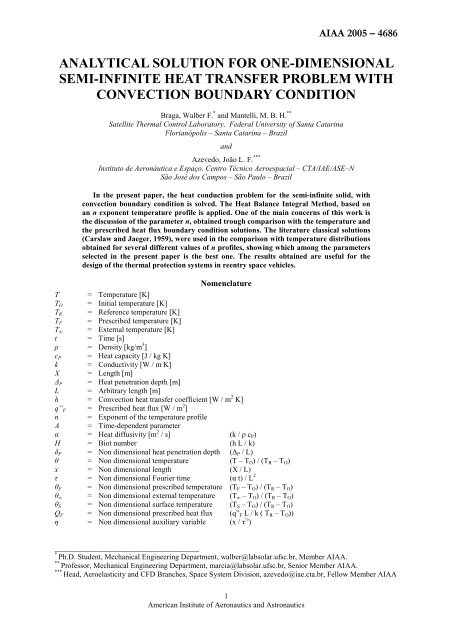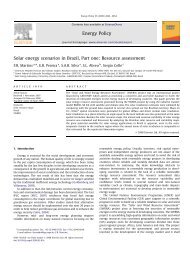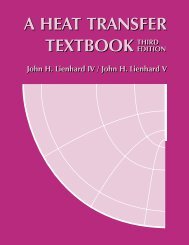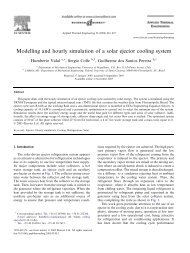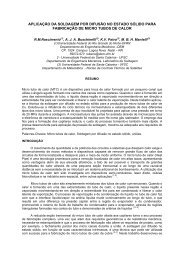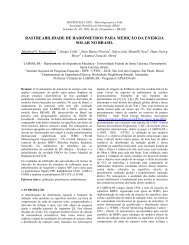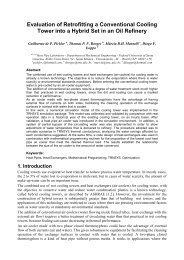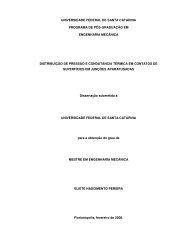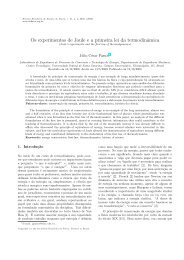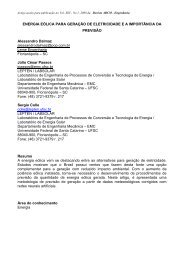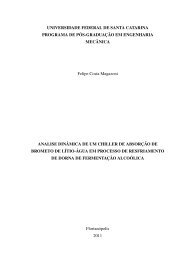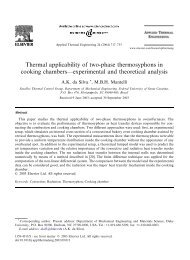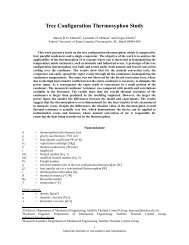analytical solution for one-dimensional semi-infinite heat - LEPTEN
analytical solution for one-dimensional semi-infinite heat - LEPTEN
analytical solution for one-dimensional semi-infinite heat - LEPTEN
You also want an ePaper? Increase the reach of your titles
YUMPU automatically turns print PDFs into web optimized ePapers that Google loves.
AIAA 2005 – 4686<br />
ANALYTICAL SOLUTION FOR ONE-DIMENSIONAL<br />
SEMI-INFINITE HEAT TRANSFER PROBLEM WITH<br />
CONVECTION BOUNDARY CONDITION<br />
Braga, Walber F. * and Mantelli, M. B. H. **<br />
Satellite Thermal Control Laboratory, Federal University of Santa Catarina<br />
Florianópolis – Santa Catarina – Brazil<br />
and<br />
Azevedo, João L. F. ***<br />
Instituto de Aeronáutica e Espaço, Centro Técnico Aeroespacial – CTA/IAE/ASE–N<br />
São José dos Campos – São Paulo – Brazil<br />
In the present paper, the <strong>heat</strong> conduction problem <strong>for</strong> the <strong>semi</strong>-<strong>infinite</strong> solid, with<br />
convection boundary condition is solved. The Heat Balance Integral Method, based on<br />
an n exp<strong>one</strong>nt temperature profile is applied. One of the main concerns of this work is<br />
the discussion of the parameter n, obtained trough comparison with the temperature and<br />
the prescribed <strong>heat</strong> flux boundary condition <strong>solution</strong>s. The literature classical <strong>solution</strong>s<br />
(Carslaw and Jaeger, 1959), were used in the comparison with temperature distributions<br />
obtained <strong>for</strong> several different values of n profiles, showing which among the parameters<br />
selected in the present paper is the best <strong>one</strong>. The results obtained are useful <strong>for</strong> the<br />
design of the thermal protection systems in reentry space vehicles.<br />
Nomenclature<br />
T = Temperature [K]<br />
T O = Initial temperature [K]<br />
T R = Reference temperature [K]<br />
T F = Prescribed temperature [K]<br />
T ∞ = External temperature [K]<br />
t = Time [s]<br />
ρ = Density [kg/m 3 ]<br />
c P = Heat capacity [J / kg K]<br />
k = Conductivity [W / m K]<br />
X = Length [m]<br />
∆ P = Heat penetration depth [m]<br />
L = Arbitrary length [m]<br />
h = Convection <strong>heat</strong> transfer coefficient [W / m 2 K]<br />
q” F = Prescribed <strong>heat</strong> flux [W / m 2 ]<br />
n = Exp<strong>one</strong>nt of the temperature profile<br />
A = Time-dependent parameter<br />
α = Heat diffusivity [m 2 / s] (k / ρ c P )<br />
H = Biot number (h L / k)<br />
δ P = Non <strong>dimensional</strong> <strong>heat</strong> penetration depth (∆ P / L)<br />
θ = Non <strong>dimensional</strong> temperature (T – T O ) / (T R – T O )<br />
x = Non <strong>dimensional</strong> length (X / L)<br />
τ = Non <strong>dimensional</strong> Fourier time (α t) / L 2<br />
θ F = Non <strong>dimensional</strong> prescribed temperature (T F – T O ) / (T R – T O )<br />
θ ∞ = Non <strong>dimensional</strong> external temperature (T ∞ – T O ) / (T R – T O )<br />
θ S = Non <strong>dimensional</strong> surface temperature (T S – T O ) / (T R – T O )<br />
Q F = Non <strong>dimensional</strong> prescribed <strong>heat</strong> flux (q” F L / k ( T R – T O ))<br />
η = Non <strong>dimensional</strong> auxiliary variable (x / τ ½ )<br />
______________________________________<br />
* Ph.D. Student, Mechanical Engineering Department, walber@labsolar.ufsc.br, Member AIAA.<br />
** Professor, Mechanical Engineering Department, marcia@labsolar.ufsc.br, Senior Member AIAA.<br />
*** Head, Aeroelasticity and CFD Branches, Space System Division, azevedo@iae.cta.br, Fellow Member AIAA<br />
1<br />
American Institute of Aeronautics and Astronautics
I. Introduction<br />
Conduction <strong>heat</strong> transfer is a very important phenomenon to the engineering science. Since the Fourier’s<br />
work “La Théorie Analytique de la Chaleur”, many mathematics methods has been developed to assist modern<br />
engineers, helping them to understand and predict the thermal behavior of different problems. Even being <strong>one</strong> of<br />
the most studied subjects on the thermal engineering field, <strong>heat</strong> conduction is still an interesting phenomenon<br />
with many challenging problems that still need to be solved. Some examples of these unsolved problems can be<br />
found within a material undergoing ablation, due to an imposed <strong>heat</strong> flux or temperature in its external free<br />
surface, as it happens in the thermal protection materials of reentry spacecrafts and satellites.<br />
The authors of the present paper have being studying <strong>analytical</strong>ly the <strong>heat</strong> conduction and ablation problems<br />
using the electrical analogy (Braga et al. 2002) 1 and the Heat Balance Integral Method (HBIM). Braga et al.<br />
(2003) 2 studied the <strong>semi</strong>-<strong>infinite</strong> conduction problem, using the HBIM, subjected to the prescribed time-variable<br />
<strong>heat</strong> flux boundary condition in its free surface. This same authors (Braga et al., 2004) 3 studied this same<br />
problem, subjected to the free surface time-constant <strong>heat</strong> flux boundary condition in a finite solid with an<br />
insulated opposite surface. In both papers, the pre-ablation and ablation phases were considered. From these<br />
previous works, it was observed the need to better understand the effect of the selected temperature profiles used<br />
at the HBIM on the accuracy of the obtained <strong>solution</strong>.<br />
As it will be described later, in all these problems the solid is subjected to pure conduction <strong>heat</strong>ing process,<br />
be<strong>for</strong>e undergoing the ablation. Table 1 shows the combination of some possible <strong>heat</strong> conduction problems <strong>for</strong><br />
the pre-ablation period, according to the boundary conditions applied. In this Table, the left two columns<br />
represent the boundary conditions applied on the right side of the solid, which can be considered <strong>semi</strong>-<strong>infinite</strong> or<br />
finite. For the finite case, the following boundary conditions can be considered: prescribed temperature (PT),<br />
prescribed <strong>heat</strong> flux (PH) or convection (C). The last three columns of Table 1 represent the free surface on the<br />
left side of the domain, which will be ablated after the appropriate temperature level is achieved (the ablation<br />
will not be considered in the present paper). The left surface can, in turn, be subjected to the same boundary<br />
conditions. All the possible combinations can be found in this table. The cases marked with an ∆ in the table<br />
were presented at previous work (Braga et al. 2005) 7 . Only the X marked case is considered in the present work,<br />
but the methodology presented can be used to solve all the remaining cases. Figure 1 illustrates the <strong>heat</strong><br />
conduction problem <strong>for</strong> the <strong>semi</strong> <strong>infinite</strong> and finite solid with the three menti<strong>one</strong>d left and right boundary<br />
conditions (PT, PH and C).<br />
The Heat Balance Integral Method (HBIM), as presented by Goodman (1964) 4 , is used in the <strong>analytical</strong><br />
<strong>solution</strong> of the present cases. In this method, an n exp<strong>one</strong>nt temperature profile is assumed <strong>for</strong> the temperature<br />
distribution. The precision of the method is directly related to the correct choice of this parameter. In the present<br />
paper, a procedure used to select the appropriate n parameter is presented.<br />
Analyzing the thermal behavior of a <strong>heat</strong>ed solid, it can be noted that, in the pre-ablation problems and, at<br />
the very first moment, the temperature profile is the same of that obtained <strong>for</strong> a simple problem without<br />
ablation. As the time goes on, the temperature increases, starting the ablation. As a consequence, the<br />
temperature profile changes and, in the limit, as time goes to infinity, it tends to that observed <strong>for</strong> a surface<br />
prescribed temperature (without ablation) problem. There<strong>for</strong>e, <strong>one</strong> can conclude that a good choice of the profile<br />
exp<strong>one</strong>nt n should be a time dependent parameter, able to capture the transition between these limiting curves.<br />
Semi-finite Solid<br />
T P<br />
q” F<br />
or<br />
h,<br />
T ∞<br />
or<br />
Finite Solid<br />
T P<br />
h,<br />
T ∞<br />
or<br />
q” F<br />
or<br />
h,<br />
T ∞<br />
or<br />
q” F<br />
or<br />
T P<br />
Figure 1. Graphic representation of the possible <strong>heat</strong> conductions problems.<br />
2<br />
American Institute of Aeronautics and Astronautics
Table 1. Possible pre-ablation problems according to the applied boundary conditions.<br />
Left free surface boundary condition<br />
PT PH C<br />
Semi-<strong>infinite</strong> ∆ ∆ X<br />
Right boundary<br />
condition<br />
Finite – PT<br />
Finite – PH<br />
Finite - C<br />
In the present paper, the Heat Balance Integral Method is used to solve the <strong>heat</strong> conduction problems <strong>for</strong> a<br />
<strong>semi</strong>-<strong>infinite</strong> solid without ablation using a time variable exp<strong>one</strong>nt temperature profile n, with a time constant<br />
convection boundary condition.<br />
II.<br />
Physical Modeling<br />
The case of a <strong>one</strong> <strong>dimensional</strong> <strong>semi</strong>-<strong>infinite</strong> solid body made of an isotropic material with constant<br />
properties is considered. The body is assumed to be at a constant initial temperature until the start up of the<br />
<strong>heat</strong>ing process, by convection on its surface. A <strong>heat</strong> transfer coefficient (H) and a constant reference<br />
temperature (θ ∞ ) are assumed. The <strong>heat</strong> is conducted inside the material, developing two different sections: the<br />
<strong>heat</strong>ed region, which the temperature is affected by the surface imposed <strong>heat</strong> and the virgin region where the<br />
material has not felt the presence of the surface <strong>heat</strong>ing, remaining at the initial temperature. The distance<br />
between the surface of the material and the front end of the regions is named as the <strong>heat</strong> penetration depth (δ P ).<br />
Figure 2 shows the physical model scheme adopted <strong>for</strong> the case under analysis.<br />
θ ∞<br />
H<br />
Heated<br />
Region<br />
Virgin<br />
Material<br />
x<br />
δ P<br />
Figure 2. Physical modeling scheme.<br />
III.<br />
Mathematical Modeling<br />
In this section, the mathematical models used to predict the thermal behavior of the problems considered are<br />
developed.<br />
A <strong>heat</strong> balance over the body (see Fig. 2) leads to the following well known transient non-<strong>dimensional</strong><br />
differential <strong>heat</strong> equation, where θ=(T –T O )/(T R –T O ), T O is the initial temperature and T R is any arbitrary<br />
reference temperature:<br />
2<br />
<br />
<br />
=<br />
2<br />
<br />
x<br />
.<br />
(1)<br />
In this equation, τ is the Fourier non <strong>dimensional</strong> time, defined as τ = (α t)/L 2 , where α is the <strong>heat</strong> diffusivity,<br />
t is the time and L corresponds to an arbitrary length. Also, x is defined as x = X / L, where X is the <strong>dimensional</strong><br />
length.<br />
The following boundary conditions are considered <strong>for</strong> these problems. If there is not a virgin region in the<br />
material, i.e., if all the solid material already experiences the presence of the <strong>heat</strong>ing imposed at the surface, the<br />
boundary condition considered <strong>for</strong> the right edge located at the infinity is:<br />
lim = 0<br />
x<br />
<br />
lim =<br />
<br />
and 0 .<br />
x x<br />
(2)<br />
3<br />
American Institute of Aeronautics and Astronautics
If there is a virgin region, i.e., if the time is not enough <strong>for</strong> the <strong>heat</strong> to reach the entire solid, the boundary<br />
conditions, located in the border line between the <strong>heat</strong>ed and the virgin regions, are:<br />
<br />
= 0 and = 0<br />
x= P<br />
x<br />
x= P<br />
.<br />
(3)<br />
At the free surface of the material, the convection boundary is given by:<br />
<br />
<br />
x<br />
x=<br />
0<br />
= H<br />
( <br />
)<br />
<br />
x=<br />
0<br />
.<br />
(4)<br />
IV.<br />
Solutions<br />
In this section, the problem under investigation will be solved, using two different <strong>analytical</strong> methods.<br />
A. Classical Solution<br />
The classical <strong>solution</strong>s found in the literature are obtained using the Laplace Trans<strong>for</strong>m technique or using a<br />
variable trans<strong>for</strong>mation, as presented by many of the classical conduction <strong>heat</strong> transfer books, such as Arpaci<br />
(1966) 5 , Carslaw and Jaeger (1959) 6 , among others. These <strong>solution</strong>s are reproduced <strong>for</strong> the problem under<br />
analyzes, as follows.<br />
For the constant <strong>heat</strong> flux at the free surface case, the <strong>solution</strong> of the partial differential equation (Eq. 1)<br />
subjected to the boundary conditions given by Eqs. 2 and 4 is:<br />
<br />
( )<br />
<br />
<br />
x <br />
<br />
<br />
2 x<br />
= <br />
erfc<br />
+ <br />
<br />
exp H x H erfc<br />
+ H <br />
2 <br />
2 <br />
.<br />
(5)<br />
The Duhamel’s theorem needs to be used to obtain the <strong>solution</strong> <strong>for</strong> a variable convection boundary condition<br />
on the free surface, when needed.<br />
B. Heat Balance Integral Method<br />
The Heat Balance Integral Method (HBIM) is based on the integral <strong>for</strong>m of the <strong>heat</strong> conduction differential<br />
equation. This <strong>for</strong>m is obtained by the integration of Eq. 1 with respect at the position x, from the solid surface<br />
(x=0) up to the <strong>heat</strong> penetration depth, (x=δ P ). Doing so, the following equation is obtained:<br />
<br />
P<br />
<br />
<br />
<br />
dx =<br />
<br />
<br />
<br />
x x<br />
0 x= P x=0<br />
. (6)<br />
As δ P is a time-dependent variable, the Leibniz rule is used and the Eq. 6 is rearranged as:<br />
<br />
<br />
<br />
<br />
d<br />
d<br />
<br />
P<br />
d <br />
P<br />
<br />
<br />
dx<br />
<br />
= <br />
x= P<br />
<br />
0 d<br />
x x<br />
x=<br />
<br />
x=0<br />
<br />
P<br />
. (7)<br />
At this point, an appropriate function has to be selected as the profile of the temperature distribution inside<br />
the material. This function must have a good agreement with the space boundary conditions and must present<br />
time dependent parameters, which are determined using the remaining initial condition. In this paper, the<br />
following profile is considered:<br />
<br />
P<br />
x<br />
A <br />
=<br />
<br />
<br />
P <br />
n<br />
, (8)<br />
4<br />
American Institute of Aeronautics and Astronautics
where A is the time-dependent parameter, calculated through the free surface boundary condition and represents<br />
the surface temperature. Physically, this parameter represents the surface temperature of the material, while n<br />
establishes the shape of the temperature profile along the solid, being arbitrarily selected. The best selection of<br />
the n value and its implications will be explained latter on this paper. The profile represented by Eq. 8 naturally<br />
satisfies the boundary conditions given by Eq. 3. Substituting Eq. 8 in Eq. 7 <strong>one</strong> gets the following ordinary<br />
differential equation:<br />
d A<br />
P<br />
d<br />
<br />
<br />
An<br />
<br />
<br />
=<br />
( n ) <br />
P<br />
+1 . (9)<br />
The prescribed <strong>heat</strong> flux problem is solved in this section. The temperature distribution (Eq. 8) is substituted<br />
in the convection boundary condition (Eq. 4), obtaining the following equation:<br />
An<br />
<br />
P<br />
= H<br />
<br />
( A )<br />
.<br />
(10)<br />
Solving <strong>for</strong> A, <strong>one</strong> gets:<br />
H <br />
P<br />
A = n<br />
<br />
H <br />
<br />
+<br />
P<br />
<br />
n <br />
1 .<br />
(11)<br />
Substituting Eq. 11 in Eq. 9 the following differential equation is obtained:<br />
H <br />
P<br />
H <br />
P<br />
d<br />
<br />
<br />
<br />
n <br />
P<br />
= n<br />
d H <br />
<br />
+<br />
<br />
+<br />
P<br />
1<br />
<br />
n <br />
n<br />
<br />
( n + 1) H <br />
P P<br />
1 .<br />
<br />
<br />
n<br />
<br />
(12)<br />
This equation can be solved <strong>for</strong> the <strong>heat</strong> penetration depth, resulting in:<br />
( n + 1)<br />
n <br />
<br />
<br />
<br />
<br />
= 1,<br />
exp<br />
2 H 2 <br />
<br />
P<br />
LambertW<br />
1 1<br />
H <br />
<br />
<br />
n <br />
<br />
, (13)<br />
which LambertW(-1, x) is the second order branch of the LambertW(x) equation. Note that all parameters H, θ ∞<br />
and n are considered time constant in this <strong>solution</strong>. Summarizing, the temperature profile is given by Eq. 8, the<br />
surface temperature by Eq. 11 and the <strong>heat</strong> penetration depth (δ P ) by Eq. 13. There<strong>for</strong>e, the only unknown<br />
variable is the n parameter.<br />
C. Comparison between the <strong>solution</strong>s obtained through the Heat Balance Integral Method<br />
The same temperature profile (Eq. 8) is adopted in the present development and in previous work (Braga et<br />
al. 2005) 7 enabling the <strong>solution</strong>s to be compared. Table 2 presents the results obtained by Braga et al. (2005) 7 .<br />
The n parameter (last line of Table 2) was deeply discussed in this paper.<br />
Just as a study case, the following configurations will be compared: prescribed <strong>heat</strong> flux with Q = 1,<br />
prescribed temperature with θ F = 1, and finally, convection with H = 1 and θ ∞ = 1. For all three cases the same<br />
n value is 2,5, due the fact that the presented <strong>solution</strong>s are highly dependent on the choice of n. Figure 3 presents<br />
the <strong>heat</strong> penetration depth and the non <strong>dimensional</strong> surface temperature as a function of time <strong>for</strong> plots all the<br />
three cases.<br />
5<br />
American Institute of Aeronautics and Astronautics
Surface Temperature<br />
Heat Penetration Depth<br />
Heat Penetration Depth<br />
(constant n value)<br />
Heat Penetration Depth<br />
Table 2. Summary of the previous HBIM <strong>solution</strong>s.<br />
Prescribed Heat Flux<br />
Prescribed Temperature<br />
<br />
<br />
P<br />
P<br />
=<br />
=<br />
A<br />
Q<br />
n<br />
F<br />
<br />
P<br />
= A = <br />
F<br />
<br />
( n + 1) <br />
n<br />
Q<br />
F<br />
0<br />
<br />
( n + 1) <br />
n<br />
Q<br />
F<br />
0<br />
Q<br />
Q<br />
F<br />
F<br />
d<br />
d<br />
<br />
P<br />
=<br />
<br />
P<br />
=<br />
2<br />
( n + 1)<br />
<br />
2<br />
F<br />
2 n<br />
2 <br />
n<br />
<br />
+<br />
0<br />
( n 1)<br />
<br />
( n + 1) 2 <br />
= n<br />
(constant n, Q F and θ F<br />
( n + 1)<br />
values) P<br />
<br />
P<br />
= 2 n( n + 1)<br />
<br />
2<br />
Optimum n parameter n = 3,66<br />
n = 1,75<br />
4 <br />
2<br />
( )<br />
<br />
F<br />
( )<br />
0<br />
<br />
<br />
2<br />
F<br />
2<br />
F<br />
d<br />
d<br />
Legend:<br />
Figure 3. Comparison between the HBIM <strong>solution</strong>s.<br />
At the Fig. 3 can be noted that the convection <strong>solution</strong> begins exactly as a prescribed <strong>heat</strong> flux <strong>solution</strong> and it<br />
tends to the prescribed temperature <strong>one</strong>s as the time goes on. It is physically explained as the following: at the<br />
very beginning, the surface temperature is equal to zero then it is suddenly exposed to a convection situation<br />
which is like to expose the surface at a prescribed <strong>heat</strong> flux defined as Q = H θ ∞ . As time goes to infinity there is<br />
very few changes at the surface temperature since it is already almost equal to the external temperature, θ ∞ . So,<br />
physically, the convection <strong>solution</strong> is a blending <strong>solution</strong> between the prescribed <strong>heat</strong> flux and the prescribed<br />
temperature <strong>solution</strong>s. The problem is that different optimum n values where obtained <strong>for</strong> each kind of <strong>solution</strong>.<br />
V. Obtaining the parameter n<br />
As described be<strong>for</strong>e, the n parameter is the exp<strong>one</strong>nt of the temperature distribution profile adopted and,<br />
generally, is arbitrarily selected. Usually, this profile has an exp<strong>one</strong>ntial function shape, which satisfies the Eq. 2<br />
boundary conditions, or a polinomium, that instead, satisfies the boundary conditions expressed by Eq. 3. In the<br />
present work, the n value is free to attain any real decimal value and to vary with time. Goodman (1964) 4<br />
presents the error (difference between classical and HIBM <strong>solution</strong>s, divided by classical <strong>solution</strong>) <strong>for</strong> some<br />
polinomium with different degrees. This author showed that the surface temperature <strong>for</strong> the prescribed <strong>heat</strong> flux<br />
condition presents large error <strong>for</strong> n = 2 (8,6%), which decreases <strong>for</strong> n = 3 (2,0%) but there is no guarantee that<br />
increasing the order of the polynomial will improve the accuracy.<br />
To find out the best value <strong>for</strong> n, the classical <strong>solution</strong>, which is exact, can be used. The strategy usually<br />
adopted is to per<strong>for</strong>m an energy balance in the solid, using both the classical and the HBIM <strong>solution</strong>s. The total<br />
energy in these cases should be the same. In the present work this procedure is not possible due the fact that,<br />
during the <strong>solution</strong> of the problem, the n parameter was assumed to be a constant value and the total energy<br />
method indicates a time variable <strong>solution</strong> to the n. There<strong>for</strong>e, in this work, an average value of n was adopted,<br />
between the optimums n of the prescribed <strong>heat</strong> flux and of the prescribed temperature problems:<br />
6<br />
American Institute of Aeronautics and Astronautics
n =<br />
2<br />
<br />
+<br />
1<br />
( 4 <br />
) ( 2)<br />
2,7<br />
.<br />
(14)<br />
<br />
<br />
<br />
<br />
VI.<br />
Comparison between the Classical Solution and the Heat Balance Integral Method<br />
The comparison between the classical and the HBIM <strong>solution</strong>s is made using the temperature profiles (Eqs. 5<br />
and 15) and the surface temperatures (Eq.16 and Eq.17). This comparison is based on the problem: H = 1 and θ ∞<br />
= 1.<br />
= 1<br />
1<br />
<br />
( n + 1) <br />
2 <br />
<br />
( n )<br />
LambertW<br />
H<br />
<br />
+ 1 2 <br />
1,<br />
exp 2 1<br />
<br />
1,<br />
exp 2 H 1<br />
1<br />
<br />
<br />
<br />
1<br />
<br />
<br />
n<br />
<br />
<br />
<br />
<br />
<br />
<br />
<br />
<br />
<br />
<br />
n<br />
<br />
<br />
LambertW <br />
<br />
x H<br />
<br />
<br />
n<br />
<br />
n<br />
<br />
<br />
<br />
<br />
<br />
<br />
<br />
<br />
<br />
(15)<br />
<br />
S<br />
<br />
<br />
<br />
<br />
= 1<br />
<br />
( n + 1)<br />
<br />
1,<br />
exp 2 H 2<br />
1<br />
<br />
<br />
<br />
S<br />
LambertW <br />
<br />
<br />
1<br />
<br />
<br />
2<br />
( 1 exp( H ) erfc ( H <br />
)<br />
= <br />
.<br />
n<br />
<br />
<br />
<br />
<br />
<br />
<br />
<br />
<br />
<br />
<br />
.<br />
(16)<br />
(17)<br />
Figure 4 presents the plots of the normalized temperature with respect to the surface temperature (θ / θ S ) as a<br />
function of the parameter η, defined as (η = x / τ ½ ). The graphic shows the classical <strong>solution</strong> (given by Eq. 5)<br />
and the others using the HIBM <strong>solution</strong>s (given by Eq. 15 and Table 2), considering different values of the<br />
parameter n (2, 2.7 and 3) and different τ values. In Fig. 5, the absolute error <strong>for</strong> the HBIM (defined as ε ABS =<br />
Eq. 5/ Eq. 17 – Eq. 15/ Eq. 16) is presented <strong>for</strong> the different n values.<br />
It can be noted in Fig. 4 that the temperature distribution curves <strong>for</strong> n = 2,7, n = 3 and the classical <strong>solution</strong><br />
present very similar shapes, being hard to distinguish among them. In Fig. 5, the absolute errors curves <strong>for</strong> the<br />
cases n = 2,7 and n = 3 have similar behavior, but the curve <strong>for</strong> n = 2,7 shows the minimum error levels, being<br />
the best choice among all the cases studied. It is interesting to note again the transitory behavior of the<br />
convection <strong>solution</strong> which goes from the prescribed <strong>heat</strong> flux <strong>solution</strong> <strong>for</strong> small τ values to the prescribed<br />
temperature <strong>solution</strong> <strong>for</strong> larger values.<br />
7<br />
American Institute of Aeronautics and Astronautics
n = 2 n = 2,7 n = 3<br />
τ = 100<br />
τ = 10<br />
τ = 0.01<br />
Legend:<br />
Figure 4. Normalized temperature profiles.<br />
n = 2 n = 2,7 n = 3<br />
Figure 5. Normalized temperature absolute errors.<br />
8<br />
American Institute of Aeronautics and Astronautics
The relative error ε <strong>for</strong> the prediction of the surface temperature can be obtained through Eq. 16 and Eq. 17<br />
(1 – Eq. 16/ Eq. 17), resulting in:<br />
<br />
<br />
<br />
1<br />
<br />
<br />
= 1<br />
<br />
<br />
LambertW 1,<br />
exp<br />
2<br />
<br />
( n + 1)<br />
2<br />
( 1<br />
exp( H ) erfc ( H <br />
)<br />
1<br />
n<br />
H<br />
2<br />
<br />
<br />
<br />
<br />
<br />
<br />
1<br />
<br />
<br />
<br />
, (18)<br />
Figure 6 presents the graphic of this error against the n parameter and the Fourier time ( τ ), using Eq. 18. It<br />
can be observed in these figures that the error depends on the n value as well as on the time. It means that a good<br />
accuracy of the surface temperature results using the HBIM depends on the time and on the value of n.<br />
n<br />
n<br />
Figure 6. Relative error of the surface temperature against the n parameter and the Fourier time (τ)<br />
VII.<br />
Conclusion<br />
In this paper the Heat Balanced Integral Method was used to solve the <strong>heat</strong> conduction inside a <strong>semi</strong>-<strong>infinite</strong><br />
solid body subjected to a time constant convection boundary condition. As part of the method, an n degree<br />
function was selected as representative of the temperature distribution of the material.<br />
The value of the n exp<strong>one</strong>nt (Eq. 8) was selected based on the temperature distribution obtained from the<br />
classical <strong>solution</strong> temperature distribution profile, which was compared with other n values. The comparison<br />
shows that the value of n = 2,7 is good to be used in these problems.<br />
It is important to note that the best value of n is very dependent on the physical behavior of the problem. Due<br />
to this fact, the authors believe that a time-constant n value is not the best choice to the convective boundary<br />
condition problem.<br />
The present case as well the others menti<strong>one</strong>d in Table 1, which were not studied in the present work, needs<br />
to be better investigated. As already menti<strong>one</strong>d in the Introduction section, a constant value of the parameter n<br />
was adopted in <strong>for</strong>mer previous modeling developed by the authors, which included ablation. The methodology<br />
presented in this paper should be used to improve the other results previously published in the literature.<br />
References<br />
1 Braga, W.F., Mantelli, M.B.H., “Electrical Analogy Modeling <strong>for</strong> One-Dimensional Ablation Problem”, 8 th<br />
AIAA/ASME Joint Thermophysics and Heat Transfer Conference, Saint Louis, AIAA, 2002.<br />
2 Braga, W.F., Mantelli, M.B.H., Azevedo, J.L.F., “Approximated Analytical Solution <strong>for</strong> One-Dimensional<br />
Ablation Problem with Time-Variable Heat Flux”, 36 th AIAA Thermophysics Conference, Orlando, AIAA,<br />
2003.<br />
3 Braga, W.F., Mantelli, M.B.H., Azevedo, J.L.F., “Approximate Analytical Solution <strong>for</strong> One-Dimensional<br />
Finite Ablation Problem with Constant Time Heat Flux”, 37 th AIAA Thermophysics Conference, Portland,<br />
AIAA, 2004.<br />
9<br />
American Institute of Aeronautics and Astronautics
4 Goodman, T.R., “Application of Integral Methods to Transient Nonlinear Heat Transfer”, Advances in Heat<br />
Transfer, Vol. 1, Academic Press, New York, 1964, pp. 51-122.<br />
5 Arpaci, V.S., “Conduction Heat Transfer”, Addison-Wesley, Menlo Park, 1966.<br />
6 Carslaw, H.S., Jaeger, J.C., “Conduction of Heat in Solids”, 2 nd ed., Ox<strong>for</strong>d University Press, London,<br />
1959.<br />
7 Braga, W.F., Mantelli, M.B.H., Azevedo, J.L.F., “A New Approach <strong>for</strong> the Heat Balance Integral Method<br />
Applied to Heat Conduction Problems”, 43 rd AIAA Aerospace Sciences Meeting and Exhibit, Reno, AIAA,<br />
2005.<br />
10<br />
American Institute of Aeronautics and Astronautics


